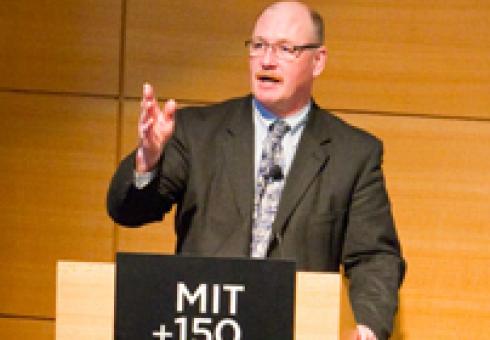Error message
- The link "../../../" is invalid. Valid URL's typically start with "https://" for external or "/" for internal links
- The link "../../../pubs/abstract.php?publication_id=2170" is invalid. Valid URL's typically start with "https://" for external or "/" for internal links
News and Outreach: John Reilly
LA Times, Dean Kuipers
Several readers pointed out an omission in last week's post about the National Oceanic and Atmospheric Administration’s release of its Annual Greenhouse Gas Index, which showed that man-made gases that contribute to global warming continued a steady rise. The post -– and the AGGI –- mentioned carbon dioxide, methane, nitrous oxide and other gases, but failed to mention the biggest contributor to global warming: plain old water vapor.
“I want to comment that the way-dominant greenhouse gas in the atmosphere is not mentioned, namely water vapor,” writes Ken Saunders of Pacific Palisades. “Water vapor accounts for about 97 percent of the total (natural plus man-emitted) greenhouse warming of the planet. See, e.g., John Houghton's ‘The Physics of Atmospheres, 3rd edition,’ Cambridge University Press, 2002.”
This is true, water vapor is the major player in the greenhouse effect and is often omitted from reports and reporting about global warming -– mostly because it is more of a symptom than a cause in global climate change, and cannot be easily mitigated.
Tom Boden, director of the U.S. Energy Department’s Carbon Dioxide Information Analysis Center at Oak Ridge National Laboratory, acknowledges in an email: “Folks are right when they state water vapor is a powerful greenhouse gas and not routinely measured directly in the atmosphere. Atmospheric water vapor is difficult to measure, highly reactive, and variable in amount due to meteorological conditions (i.e., atmospheric water vapor is continuously being generated from evaporation and continuously removed by condensation).”
“Water vapor is the most important greenhouse gas and natural levels of [carbon dioxide, methane and nitrous oxide] are also crucial to creating a habitable planet,” writes John Reilly, professor at MIT and co-director of the Joint Program on the Science and Policy of Global Change, Center for Environmental Policy Research, in an email.
That idea leads many to believe that global warming is natural and cannot be affected much by human activity. Reader Roy W. Rising of Valley Village writes: “Today's report focuses on a bundle of gases that comprise a very small part of total of ‘greenhouse’ gases. It totally disregards the long-known fact that about 95% of all ‘greenhouse’ gases is WATER VAPOR! Spending billions of dollars to alter a few components of the 5% won't affect the natural course of climate change.”
Reilly warns, however, that scientists don’t blame water vapor or clouds for global warming.
“Concerns about global warming are about how human beings are altering the radiative balance,” says Reilly. “While some of the things we do change water vapor directly, they are insignificant. Increasing ghg's [greenhouse gases] through warming will increase water vapor and that is a big positive feedback [meaning: the more greenhouse gases, the more water vapor, the higher the temperature]. But the root cause are ghg's. So in talking about what is changing the climate, changes in water vapor are not a root cause.”
Click here to read the rest of the story reported by the LA Times.
Competing demands for food, fuels, and forests
How do you value an ecosystem? Putting a dollar value on natural systems such as forests has long beset economists.
Forests provide “non-use values,” such as the pleasure of knowing that a natural system exists, and recreational values, such as hunting, fishing and wildlife viewing. But recently, ecologists have also sought to value a broader set of “ecosystem services,” or the goods and services that ecosystems provide to a market economy.
Ecosystem services related to land include conventional food and forest products, as well as the potential to produce biofuels. But ecosystems also have the ability to store carbon. If a price on carbon were established, an incentive to enhance carbon storage would be created. This new ecosystem service would need to be balanced against conventional food, forestry and biofuels production services. As the number of ecosystem services expand and are fully priced in a market, the demand for land naturally increases.
Researchers from the MIT Joint Program on the Science and Policy of Global Change have used an economic model to explicitly represent recreation value of ecosystems and their carbon storage value. The study examines how demand for ecosystem services will affect land use, food prices and the prospects for biofuels production.
Their study found that growth in demand for biofuels increases when a carbon tax is implemented, leading to increases in CO2 emissions from the conversion of forests to cropland. However, if that carbon tax also includes emissions from land use change, the resulting economic incentive is enough to avoid deforestation. And, if a tradeable credit program to incentivize CO2 sequestration on land is implemented, significant reforestation occurs, such that land use becomes a large net sink for CO2.
This is a surprising result, as land use emissions currently make up about 20 percent of total emissions. But, with carbon taxes and a tradeable credit program, land use would mitigate emissions by storing carbon in forests and replacing fossil fuels with biofuels. In fact, the analysis shows that if carbon storage were credited, land conversion would eventually store as much as one third of the entire global energy emissions over the coming century.
Unfortunately, it’s not that simple — such policies would imply some difficult tradeoffs. In the scenario with full carbon pricing, substantial reforestation and biofuels production occurs, but at the expense of conventional agricultural products. The two new non-food demands for land cause commodity prices to increase, especially impacting livestock prices. The livestock sector is particularly affected because both the rental prices for grazing land and the price of grains used to feed livestock rise. As food prices rise, poor consumers will be considerably affected and may suffer.
“Since conventional agricultural goods are priced in markets, the higher [food] prices projected are efficient in the sense that they reflect the marginal value of storing carbon that would be lost if more land were devoted to food production,” explains John Reilly, co-director of the MIT Joint Program and co-author of the study. He adds, “However, the market values do not take into account equity considerations, and so in the absence of food programs worldwide such higher prices would place a disproportionate burden on lower income people.“
Some of the resulting increase in food prices may be offset by future agricultural technology. But even with such technologies, increasing food prices would still be a substantial departure from the historical trend of falling food prices. As new demands for land stem from an expanded view of ecosystem services, special attention will be needed to counteract the impacts on development and food security.
“It is a dilemma where climate change itself may have negative consequences for food production but extensive reforestation to limit climate change may also squeeze food production by limiting the land available for conventional agriculture.
Thrown on top is a demand for land for biofuels production that could put further pressure on food prices,” Reilly says. “The results are a cautionary tale in embracing efficient market solutions in a world where there are not ready mechanisms to deal with inequitable outcomes.”
With rising energy prices, could coal-to-liquid conversion become an economical fuel option?
Converting coal into liquid fuels is known to be more costly than current energy technologies, both in terms of production costs and the amount of greenhouse gases the process emits. Production of coal-to-liquid fuel, or CTL, has a large carbon footprint, releasing more than twice the lifecycle greenhouse gases of conventional petroleum fuels. However, with the rise in energy prices that began in 2008 and concerns over energy security, there is renewed interest in the conversion technology.
Researchers from the MIT Joint Program on the Science and Policy of Global Change (JPSPGC) recently released an assessment of the economic viability of CTL conversion. The researchers looked at how different climate policies and the availability of other fuel alternatives, such as biofuels, would influence the prospects of CTL in the future.
Coal-to-liquid technology has been in existence since the 1920s and was used extensively in Germany in 1944, producing around 90 percent of the national fuel needs at that time. Since then, the technology has been largely abandoned for the relatively cheaper crude oil of the Middle East. A notable exception is South Africa, where CTL conversion still provides about 30 percent of national transportation fuel.
But will there be a resurgence of CTL technology? To determine the role that CTL conversion would play in the future global fuel mix, researchers examined several crucial factors affecting CTL prospects. Different scenarios were modeled, varying the stringency of future carbon policies, the availability of biofuels and the ability to trade carbon allowances on an international market. Researchers also examined whether CTL-conversion plants would use carbon capture and storage technology, which would lower greenhouse gas emissions but create an added cost.
The study found that, without climate policy, CTL might become economical as early as 2015 in coal-abundant countries like the United States and China. In other regions, CTL could become economical by 2020 or 2025. Carbon capture and storage technologies would not be used, as they would raise costs. In this scenario, CTL has the potential to account for about a third of the global liquid-fuel supply by 2050.
However, the viability of CTL would be highly limited in regions that adopt climate policies, especially if low-carbon biofuels are available. Under scenarios that include stringent future climate policies, the high costs associated with a large carbon footprint would diminish CTL prospects, even with carbon capture and storage technologies. CTL conversion may only be viable in countries with less stringent climate policies or where low-carbon fuel alternatives are not available.
“In short, various climate proposals have very different impacts on the allowances of regional CO2 emissions, which in turn have quite distinct implications on the prospects for CTL conversion,” says John Reilly, co-director of the JPSPGC and one of the study’s authors. “If climate policies are enforced, world demand for petroleum products would decrease, the price of crude oil would fall, and coal-to-liquid fuels would be much less competitive.”
Press Release:
Top economist will work with experts around the world to address global food issues
May 24, 2011 (MILAN) – John M. Reilly, Co-Director of the MIT Joint Program on the Science and Policy of Global Change, is now the newest member of the Barilla Center for Food and Nutrition (BCFN) Advisory Board, a panel of top health, food, environment, economy and medical experts around the world. Dr. Reilly will collaborate with other BCFN experts and Board members to analyze and develop proposals on pressing global food and nutrition issues.
The BCFN is a think tank established to gather global knowledge on food, analyze it and propose solutions to negotiate the challenges of the future. It aims to encourage general well-being through a healthy and sustainable approach to food. Over the last three years, the BCFN has published 11 works on the subjects of environmental sustainability, relationship between food and health in adults and children, access to food resources and cultural value of food.
“An integrated look at the food system considering the nutrition and health of consumers, the environmental sustainability of the production system, and its potential vulnerability to climate and environmental change is much needed as we look ahead to a growing world population and increased threats of environmental change,” Dr. Reilly said. “I look forward to working with the BCFN on these topics and expect to learn as much as I contribute given the outstanding group of experts the center has assembled to support their work.”
Dr. Reilly, an energy, environmental and agricultural economist, focuses on understanding the role of human activities as a contributor to global environmental change and the effects of environmental change on society and the economy. A key element of his work is the integration of economic models of the global economy as it represents human activity with models of biophysical systems, including the ocean, atmosphere and terrestrial vegetation.
“Our board members are the best in their fields, and we are excited to have Dr. Reilly join us,” said Guido Barilla, BCFN Chairman. “His experience and research on energy systems and the intersection of the economy and the environment will be key to our future research on the sustainability issues of the food and nutrition industry.”
The BCFN Advisory Board ensures that the most advanced knowledge and foremost professional capacities are used to address the BCFN’s specific themes and to enhance and refine the quality of its work. The members identify topics of interest, develop distinctive and scientifically valid content and make proposals and recommendations. Dr. Reilly will join the current members:
- Barbara Buchner, Director of the Climate Policy Initiative of Venice
- Mario Monti, President of the Università Bocconi of Milan
- Gabriele Riccardi, Professor of Endocrinology and Metabolic Pathologies at the Università degli Studi of Naples
- Camillo Ricordi, Professor of Surgery, Medicine, Biomedical Engineering, Microbiology and Immunology at the University of Miami
- Claude Fischler, Directeur de Recherche at CNRS
- Umberto Veronesi, Scientific Director of the European Institute of Oncology of Milan
About the Barilla Center for Food and Nutrition
The Barilla Center for Food & Nutrition is a multidisciplinary think tank focusing on issues of food and nutrition and their relations to economics, medicine, diet, sociology and the environment.
The work of the Barilla Center for Food & Nutrition is backed by an authoritative Advisory Board composed of Barbara Buchner, Director of the Climate Policy Initiative of Venice; Jean-Paul Fitoussi and Mario Monti, economists; Gabriele Riccardi, endocrinologist; Camillo Ricordi, surgeon and scientist; Claude Fischler and Joseph Sassoon, sociologists; and Umberto Veronesi, oncologist.
by John Reilly with Henry Jacoby, Ronald Prinn, and Richard Schmalensee
Huffington Post, May 20, 2011 Recent research has shown that over the next few decades an effective U.S. climate policy to significantly reduce greenhouse gas emissions would rely on extensive reductions in energy use and substitution of natural gas for coal in power generation. The second pathway -- gas-for-coal -- is premised on the fact that natural gas, when combusted, produces 50 percent lower CO2 emissions than coal.
Recent research has shown that over the next few decades an effective U.S. climate policy to significantly reduce greenhouse gas emissions would rely on extensive reductions in energy use and substitution of natural gas for coal in power generation. The second pathway -- gas-for-coal -- is premised on the fact that natural gas, when combusted, produces 50 percent lower CO2 emissions than coal.
A recent paper by Cornell Professor Robert Howarth and others in Climatic Change Letters calls the gas-for-coal solution into serious question, suggesting that natural gas power generation is twice as greenhouse gas (GHG) intensive as coal. Howarth bases this conclusion in part on his assessment of methane leakage in the production stages of natural gas, with a specific focus on new methods to produce unconventional shale gas.
Natural gas is primarily methane. There are methane leakages at different stages of the production process, as well as CO2 emissions when natural gas is burned to generate electricity. Methane is a powerful GHG but, unlike CO2, which resides in the atmosphere for over a century, methane lives in the atmosphere for around a decade.
The Howarth study raises some legitimate questions about the uncertainties surrounding associated estimates of methane emissions -- but Howarth's conclusions depend on a couple of unsound assumptions.
First is the metric Howarth used to compare the warming impact of methane to that of CO2. This can be a complex calculation, because there are several different kinds of GHGs with different life spans and varying impacts on the climate.
To make a comparison among these different GHGs, whose lifetimes can range from a few to thousands of years, the "global warming potential" (GWP) concept was developed in the 1990s. In general, policymakers have focused on GWPs calculated over a 100-year period, although the Intergovernmental Panel on Climate Change (IPCC) also calculated GWPs over 20- and 500-year periods.
The choice between 20-, 100-, or 500-year GWPs comes down to whether one wants to measure the near-term impacts of global warming or the longer-term impacts. Choosing an index based on 20 years, as Howarth has done, largely ignores serious longer term risks of climate change, masking the urgent need to immediately start controlling those GHGs that will remain in the atmosphere for hundreds to thousands of years.
Howarth's choice threatens to tilt critical policies away from some of the more dangerous risks we face in the longer term, focusing us instead on near-term and largely manageable gas production methane leakage. For these reasons, his choice of the 20 year GWP is outside the norm -- indeed, EPA, DOE, the California Air Resources Board, and others routinely use the 100 year GWP in their policy analysis.
Howarth also assumes a gas power generation efficiency as low as 28 percent. That figure can be misleading, because it applies not to the "base-load" generation units that would compete with coal to meet the consistent daily electricity demand of consumers, but to "peaking units" which help meet variable demand in electricity. Peaking units have relatively low efficiencies, in the range suggested by Howarth.
Natural gas base-load units have efficiencies in the 40-54 percent range, compared to 30-35 percent for the current fleet of coal plants. The higher the efficiency, the less CO2 is emitted for every kilowatt hour of electricity produced.
Recalculating the gas-coal comparison using Howarth's methane emissions figures -- but sticking with the 100-year GWP and more accurate gas unit efficiencies -- shows roughly 50 percent lower greenhouse gas emissions from natural gas generation compared to coal generation.
Finally, it is important to recognize that methane leakage from natural gas production is wasted product with economic value: gas producers have a financial incentive to capture this methane. And ideally, climate policy through a GHG price would penalize methane leakage, providing producers with additional incentives for capturing methane.
Reduced energy use and coal-to-gas substitution could provide a bridge to a low carbon future, enabling us to move forward on climate change mitigation while we continue critical research on other more advanced technologies. Energy alternatives require close scrutiny for their range of impacts on the environment -- the environmental effects of shale gas are no exception.
It would, however, require much more compelling evidence and analysis to persuade us that we should actually use more coal and less natural gas power generation, a logical conclusion from Howarth's paper. Calculations that test conventional wisdom are important in driving further scrutiny. The preponderance of the evidence, however, continues to support the conclusion that substitution of gas for coal in power generation is an important component of a sensible and effective near-term climate change policy.
A novel study by the MIT Global Change Joint Program concludes that increasing levels of ozone due to the growing use of fossil fuels will damage global vegetation, resulting in serious costs to the world's economy. The analysis, reported in the November issue of Energy Policy, focused on how three environmental changes (increases in temperature, carbon dioxide and ozone) associated with human activity will affect crops, pastures and forests.
More: Reprint 2007-11








